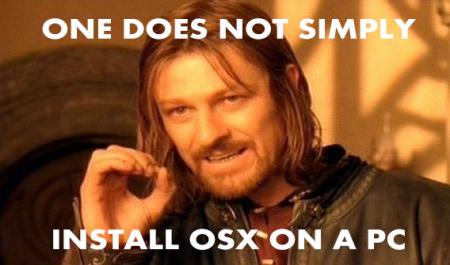-
Posts
133 -
Joined
-
Last visited
-
Days Won
1
Content Type
Profiles
Forums
Downloads
Posts posted by chmod1337
-
-
Why would you want to do such a thing?
I mean if you are using debian squeeze, you should know that Debian stable is always a bit outdated (but rock solid) and doesn't offer the same performance as Debian testing or a different GNU/Linux distro.
Also I cannot think of many Linux applications that would benefit from a few percent extra performance at the price of stability, except gaming and we all know gaming and especially reasonable graphics drivers is more of a Windows thing.
Overclocking tools not working in Wine is what I would expect, I wouldn't even try. Wine tries to provide basic interfaces for windows software that wants to use these interfaces. Basic interfaces not some complex interfaces that allow direct hardware manipulation.
-
Time to get a BGA soldering station... no wait, I stick with AMD.
On the other hand I always wanted a BGA soldering station... hmm
-
 1
1
-
-
I am running a wndr3700 v2 as router with the modem attached in pppoe mode, this seemed to be the only reasonable way to do port forwarding without getting the modem in the way.
The router runs openwrt and is absolutely stable. However I also noticed a strange thing when doing port forwardings between WAN and realDMZ. I actually had to allow forward the ports to the security zone LAN, in order to get the packages delivered to the address in the DMZ. I never investigated the issue, because I assumed it was a software bug (bleeding edge firmware), but now that I hear of software independent issues, I might take a look at this once I have more time.
-
Wow, great article guys. I was kind of outdated concerning graphic cards, but now I know what to buy, if I had spare money.
ConkersGrillforce1337 posted a windows 7 windows 8 performance comparison yesterday. Would be interesting to see if this has the same effects on your benchmarks.
-
 2
2
-
-
CPU support is quite good today, at least with technologies like svm (amd) and vt-d (intel) it is possible to achieve 80% of the native performance of the host. If you allow the host OS to be modified (linux only atm) you can use paravirtualization, which allows for up to 98% of the original performance. But we are only talking about cpu performance here. As long as you can keep memory usage modeate, virtualization doesn't create a bottleneck here. But typical I/O has a lot of overhead, e.g. hdds are usually one/multiple file(s) on a physical hdd, so performance regarding random access is be really bad. Networking is also a complicated thing and the influence of tcp checksum offloading seems to be an important, but also hardware dependant factor. Video has always been a difficult thing and will likely not become efficient in the near future, the reason being the amount of legacy in todays video architecture.
Special drivers in the guest seem to ease some of those problems, but in the end they still do not allow things you'd use on a regular desktop like video / gaming.
-
Bonjour et bienvenue chez T|I @Jostechino
-
WNDR3700, i have two of them, one as wifi access point, the other just for routing. Working perfectly with openWRT, except for regulatory domains (wifi), but the wiki has a fix there.
If 300mbps isn't quite enough, there is still the WNDR4500, 450mbps in 5ghz, 300mbps in 2.4ghz band. Also works good here, but is more expensive. If you want more speed or usb ports this one is certainly a good choice.
All of them running cool.
I used to like linksys (once cisco for home users), but now most of their better products go with a label like "linksys by CISCO" but the are not the cisco quality.
So i switched to netgear (the samsung of networking gear
 ) and so far (few years) I am pretty happy with it.
) and so far (few years) I am pretty happy with it. -
Once again, we can thank pirates and thieves for stuff like abusing SLIC mods to ruin things for the honest majority.
While I do understand your point and think it is a valid point, there is also another side to piracy.
A pirate is interested in compromising technology in order to make a profit,in doing so he also forces the industry to react. Leading to a cat and mouse game. In the first moment, this might seem undesirable and a waste of resources, which the consumer has to pay. But the cat and mouse aren't the only players in this game, big brother is part of the game as well. Governmental agencies (not always our own and/or trusted ones) use weaknesses in technology to spy on us, sometimes they even seem to have introduced created those technological weaknesses themselves.
Under this preconditions it might be desirable to have someone who constantly forces manufacturers to change technology.
Of course it is desirable that such work is done by honest hackers, but those usually do this work in their spare time. Pirates have a big motivation thanks to the money they are after and because they are actively using exploits, the force they create on the industry is much stronger.
I know, it might seem like a SLIC hack has not much to do with security. But when you look at some of the more advanced security exploits, you see that often a seemingly harmless technology becomes a lever to exploit the actual security flaw.
I guess what I want to say is, don't worry about the game change, it will soon enough change again giving someone else a momentary advantage.
-
could someone explain how this is to do with microsoft, I am confused.. and what is SLIC modding?
The SLIC is a table in the bios, put there by big OEMs. Together with a certificate (manufacturer specific) and a licence key ((manufacturer)/edition specific) it allows you to activate windows offline.
The forums at mydigitallife.info know more:
-
 2
2
-
-
Should have closed the tread before it became a playground for hobby lawyers...

Also I would like to ask you to use the word piracy carefully. It is often used by media and think tanks (content industry), but in most cases it is not the (legally) appropriate term.
I am not going to close the thread, but I ask you to stay on topic and to source (link or quote) your claims.
-
Well, there is still the option of renting a mac in the cloud...
-
-
-
for what reason do you clear the screen, if you are going to reboot anyway?
There are reboot tools for dos, but ctrl+alt+del should be safe. DOS is a single tasking operating system (at least variants you guys use), so there is no other task in the background you could corrupt by forcing the computer to shut down.
-
Wait a minute, you are saying, the 240 is actually encoded as ascii? So in order to make use of this information the computer(bios at this stage I guess) has to convert those ascii character to an int. Sounds like a job for an atoi-function or a lookup-table; If it is a lookup-table one could simply modify it, but what I really wonder about is how the computer makes use of this information, if it does at all.
-
No, I can't download it from Dell too.
As long as you don't have 5 quality posts or elite membership you can't download it from here either. ->see forum rules!
oh and congratulations on your first post

-
Thank you @Nospheratu this is just what I have always been wondering about.
I suspect the resistor that is connected accross the chip determines the wattage of the PSU. If so, one could try to reverse engineer another PSU to see if it has a different resistor, or maybe even simpler, connect a variable resistor and see how the notebook behaves. But then again why make it so simple? The resistor probably has to match the ID chips programming or has nothing to do with it at all.
@svl7 please provide your opinion and/or investigate, because I don't have a Dell Notebook.
-
Yes funny, but I guess if you don't understand german it sounds even better.
-
Do you guys still remember those Youtube videos with outtakes from the film Downfall, showing Adolf Hitler subbed with completely different subtitles?
Well, they are back! - Gangnam Style
No link provided
-
 1
1
-
-
As I already said in my previous post, it is not a good idea to put different OSes and Tools onto the same USB drive, because in doing so, YUMI and other tools have to move the files to seperate folders in order to prevent name collisions. But doing so breaks routines with hard coded paths and you won't know about that until you are halfway through the installation process.

If you really want to have multiple OSes an Tools on a single pendrive, you can still partition it and install a bootmanager like grub4dos. But then again why not get a couple of smaller usb drives? This is probably even more cost effective.
PS: this really sounds like a bios problem to me. But it is kind of akward, because I was under the impression that as long as there is some magic boot sequence on the drive the bios will (try to) boot it. Have you tried to booting the pendrive on another PC, not just Qemu?
-
 2
2
-
-
Well, I haven't heard of such an issue before, but I had troubles with such tolls as YUMI, Xboot or unetbootin. The problems usually arised, because the pendrives wouldn't boot at all or because the installers didn't preserve the folder structures exactly, which lead to problems during the installation.
In the past I switched to a somewhat different installation procedure, which unfortunately isn't suported by all computers.
You can write an 1:1 copy of an cdrom iso onto a pendrive with dd (if you don't know dd, it is a tool for low level copying) and most computers will boot it just fine.
dd if=/path/to/your/file.iso of=/dev/sdxx being the letter of your usb pendrive and NOT your harddrive, you can also append bs=10M for bigger than default blocksize, for increased speed.
If you are running Windows and no GNU/Linux, you need to get dd first (and you might want to add it you your systems path variable). You can get it with the Unix tools for Windows or Cygwin, both worked for me.
PS: If you find out what really caused your problems, I'd be glad to hear from you.
-
 2
2
-
-
PS: If you buy some flat magnets and glue, you can make fridge magnets from the old keyboard

-
 3
3
-
-
I have the HP Elitebook 6930p and successfully exchanged the keyboard with an ebay version after I killed the Alt Gr key (once you don't have it anymore, you realize how often you need this key).
Swapping was very simple because HP designes their products to be as modular as possible. It was only 3 screws in the back and the 4 latches on the keyboard. AFAIK this does not even void your warranty (Phillips screws).
The only tricky thing is to get the flat cable back into the connector, but if you don't have 2 left hands this should be fairly easy.
As far as I understand Keyboards, they are all more or less the same only the printed characters differ. The computer interprets the keys with the help of the keymap(control panel), which of course has to match your physical keyboard in order to make any sense.
I honestly don't see anything you should be worried about, except the (sometimes exorbitant) price.
-
 2
2
-
-
@chmod1337 may be able to help you with virtualization questions.
Well, not quite my league.
Xen is one thing..., Citrix, well let me think how to say this... - too proprietary.
But maybe if you have more specific questions I could be of help.
-
 2
2
-






How Do I Overclock in Linux? M14XR1 Debian Squeeze A08
in Alienware M14x / AW 14
Posted
Debian Testing is far from beeing beta, it simply is a rolling release. Btw, if gnome3 is the reason you don't want to upgrade have a look at mate, a gnome2 fork.